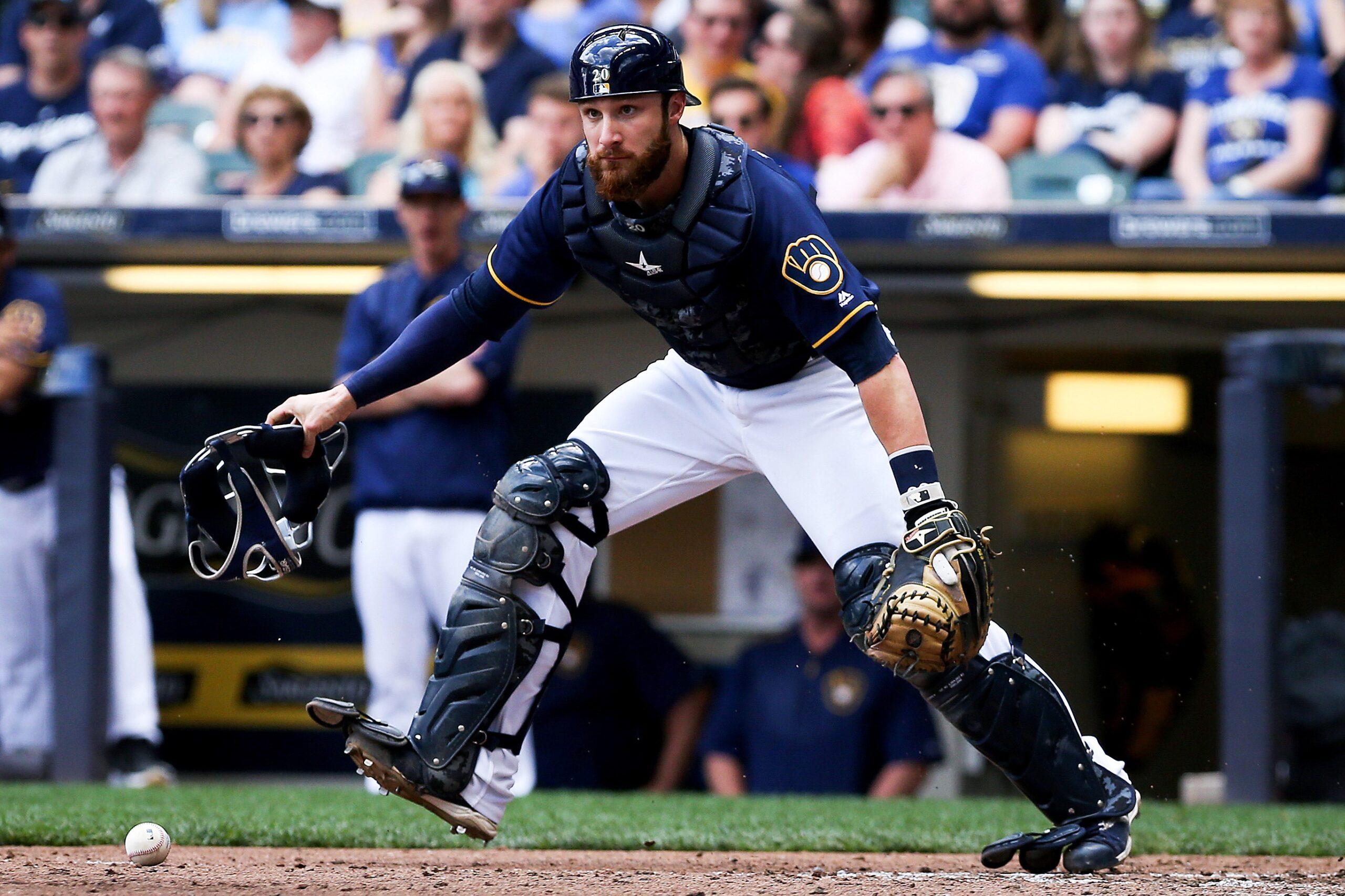Last winter, Jonathan Lucroy requested a trade in a most Midwestern way. The Brewers catcher didn’t demand to be dealt. He simply remarked that a trade would be best, attempting to steer GM David Stearns toward a desired outcome the way Jeeves did with Wooster. Analyzing the situation “objectively and without bias,” Lucroy said that he wanted to win and wasn’t likely to do that with the rebuilding Brewers. Analyzing the situation subjectively and with bias, some Brewers fans said, in essence, “screw you.” (Others were not as nice.)
Lucroy wasn’t wrong about the team’s short-term prospects, but Stearns disagreed with his read of the Brewers’ best course. Hired away from the Astros in September 2015 to take over a team that was already divesting veterans, the young GM continued to remake Milwaukee’s roster, completing nine offseason trades in which he moved five more major leaguers. Lucroy wasn’t one of them.
Although the Brewers didn’t add any notable names, their low-key offseason infusion of other teams’ minor league talent still drew rave reviews: FanGraphs’ Dave Cameron ranked their winter’s work second best behind the Cubs’. As Donald Trump’s ghostwriter regrets saying, though, “sometimes your best investments are the ones you don’t make.” The Brewers acquired a catcher and had chances to trade Lucroy, but they were wise not to take them. Now they have something almost everyone wants.
Lucroy, who turned 30 last month, still isn’t famous by superstar standards; when he made Sports Illustrated (fine — for Kids) last July, the cover called him Matthew, an unintentional homage to a less-accomplished catcher who retired almost 10 years ago. But his stats are superstar good: He ranks eighth among position players in Baseball Prospectus’s Wins Above Replacement Player since 2011, his first full season. That’s despite a down year in 2015, when his glove, bat, and body broke down; he missed 41 days after a foul tip off his toe, and another 15 after a foul tip off his face. (Don’t play catcher, kids.) The second foul caused a concussion, and because it occurred in September, Lucroy didn’t catch after his comeback. In the wake of concussions that ended Joe Mauer’s and John Jaso’s catching careers, teams were understandably wary of paying for the elite Lucroy that the Brewers still believed would be back. A winter trade might have been best for Lucroy, but for Milwaukee it would’ve qualified as a classic sell-low deal.
Lucroy, who worked hard to become a best-shape-of-his-lifer, isn’t 100 percent of the player he was in 2014, when he finished fourth in NL MVP voting. He’s making a little less contact, and his framing has fallen from best in class to a bit above average. But he’s back to being an All-Star, and he’s on pace for his fifth five-win full season in six tries. Thanks to Lucroy, who hasn’t lost a game to an injury and ranks fifth in innings caught, the Brewers have earned 2.6 WARP from their catchers, third best behind the Giants (Buster Posey) and the Nationals (Wilson Ramos, whose new eyes and new body granted him greenseer-esque powers this spring).

Factoring in his $4 million 2016 salary and his similarly team-friendly $5.25 million option for 2017, Lucroy has a convincing claim to the title of most valuable player likely to move on this summer’s mediocre trade market. Of the 25 trade candidates on MLBTradeRumors’ most recent list, only fellow Brewer Ryan Braun is expected (by PECOTA, Baseball Prospectus’s projection system) to produce more WARP over the rest of the season. But Braun will turn 33 in November, and the nearly $91 million in salary he’s still owed through 2020 is a commitment few teams want to take on, unless Stearns tries to get really creative and pair Braun and Lucroy together in a Craig Kimbrel–Melvin Upton maneuver. Of course, PECOTA is probably underrating Rich Hill, Oakland’s better, stronger, and faster six-million-dollar man. But even if Hill (who’s suffering from a blister) is the AL’s best pitcher, he’s at most a three-month rental who wouldn’t net his new team a compensatory draft pick if he signed elsewhere in the offseason.
Lucroy, who won’t reach free agency until 2017, is an intoxicating combination of inexpensive and skilled. PECOTA forecasts Lucroy for roughly six WARP through next season, with one-third of that coming this year. If we assume that teams are willing to pay free agents close to $9 million per projected win, Lucroy’s remaining contributions would command more than $50 million on the open market, dwarfing the $7.5 million or so he’ll actually earn over the life of this deal. That gives him essentially the same surplus value as a top-10 hitting prospect (such as Brewers top prospect Orlando Arcia). You can see why Stearns’s asking price is so high.
So which teams might meet it? The good news for Milwaukee and Lucroy — who has an eight-team no-trade clause he’d likely be willing to waive — is that there’s no shortage of teams with a need, if not as many with the young talent it would take to sway Stearns. The Tigers, White Sox, and Mariners would love Lucroy: The three teams are tied with 0.3 WARP apiece from their catchers, with little reason to hope for much more. But their thin farm systems have one top-100 prospect between them (Mariners outfielder Alex Jackson), which would force them to raid their major league rosters, offsetting some of the benefit from adding Lucroy. And with single-digit divisional odds, only slightly less remote wild-card odds, and uncertain outlooks for next season, they might not be in the mood for much shopping.
That leaves the Mets, Indians, Astros, Rangers, and Red Sox. The Mets’ David Wright– and Lucas Duda–less lineup would look a lot better with Lucroy, who could platoon with James Loney at first in the unlikely event that Travis d’Arnaud stays healthy for the whole second half. The Indians’ -1.0 WARP from their catchers has been one of the biggest black holes in baseball, and the responsible party, Yan Gomes, just hit the DL with a shoulder strain after offering an insufficient slump-busting sacrifice to Jobu (a Target rotisserie chicken). Lucroy would be a big upgrade, and his economical contract has extra appeal to the majors’ second-lowest-attendance team. Although Opening Day backup catcher Roberto Pérez is back from a broken thumb, the most recent bad news about Michael Brantley may have made Cleveland more eager for offense, bumping Lucroy up the team’s list of targets.
The Red Sox already have the best offense in baseball, but despite Sandy León’s small-sample hot streak, catcher is a weak link in their lineup. While the Sox probably wouldn’t part with their top-10 prospect, they have enough next-tier names to get a deal done. (They could also include catcher Christian Vázquez, the defensive prodigy they demoted after his glacial start at the plate.) The two teams have already connected on one trade this month, and if Trader Dave Dombrowski goes 10 days without a deal, he’s liable to start releasing prospects just to feel alive. Lucroy would give him his fix, as well as a head start on replacing the runs lost next season if David Ortiz proceeds with his dastardly plan to retire.
Like Boston, the two Texas teams are in a dogfight for first place — and in a head-to-head race, which means that either would derive some additional benefit from blocking the other. We know both teams have had interest, and we know Stearns is an expert on the Astros’ system, with close ties to the top brass. The Astros also have a top-10 hitting prospect, shortstop Alex Bregman, who’s searching for a position after being blocked in the infield by both Carlos Correa and recent signee Yulieski Gurriel. The hurdle on Houston’s end is that current catcher Jason Castro’s bat has rebounded, and he’s third in framing runs. While Lucroy could also fill in at first base, a team without an acute weakness at catcher wouldn’t part with an appealing enough prospect to bring him aboard. The Rangers, meanwhile, have plenty of prospects and the greater need, which probably makes them the leader in the Lucroy clubhouse.
Despite the strong market for Lucroy’s services, the Brewers don’t have to trade him right now. If they keep him past the deadline, he’ll still stand out next to this winter’s free-agent catching class, which, like last year’s, is headlined by Matt Wieters, Jarrod Saltalamacchia, and Alex Avila (with Castro adding a fourth league-average-ish bat to the bunch). But each passing day subtracts a sliver of his value — and, in theory, of the Brewers’ return. So even if Stearns can’t land the perfect midseason haul before he has to put down his pencil, an imperfect package might beat the best offseason option. Contenders will keep vying to convince him that’s so; the best-laid plans can be foiled by the next foul tip, but a healthy Lucroy could decide a division.


